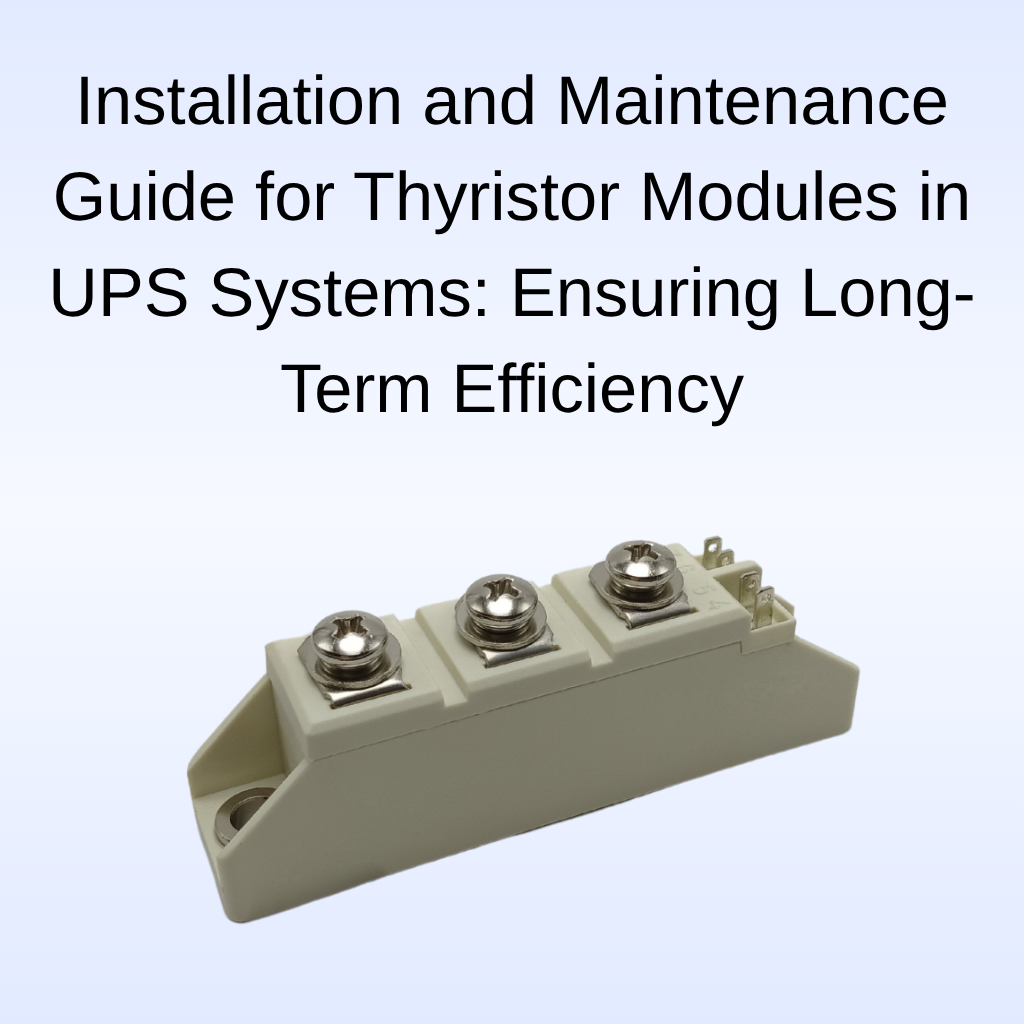Installation and Maintenance Guide for Thyristor Modules in UPS Systems: Ensuring Long-Term Efficiency
Thyristor modules are essential for the operation of Uninterruptible Power Supply (UPS) systems, providing the controlled power flow necessary to maintain continuous operation of sensitive equipment during power disturbances. These modules must be installed and maintained properly to ensure their efficiency, reliability, and longevity. This guide covers key installation steps and maintenance practices, including the importance of features such as high surge current, low on-state voltage, and industrial phase control.
Step 1: Installation of Thyristor Modules
The successful installation of thyristor modules directly impacts the performance and longevity of a UPS system. Proper installation ensures that the system runs efficiently, with minimal risk of component failure. Key considerations for installing thyristor modules include:
Compact Package Design: Many thyristor modules come in a compact package for easy integration into UPS systems. Before installation, ensure that the available space allows for proper ventilation. Adequate airflow is essential to prevent overheating, especially during periods of high power demand.
Corrosion Protection: Most thyristor modules are anodized to improve their resistance to corrosion. During installation, check that the anodized surfaces are intact and undamaged, especially in environments where moisture or corrosive agents may be present.
Power Converter Integration: Thyristor modules play a key role in the power converter function of a UPS system. Ensure that the modules are properly integrated into the power converter circuit to allow for efficient conversion from DC to AC power. Incorrect wiring or connections could result in inefficiencies or even failure of the UPS system.
Handling High Surge Current: UPS systems frequently experience high surge currents during startup or load transitions. It is critical to select thyristor modules that are capable of handling high surge current without causing damage. Ensure the modules are rated for high surge handling to protect the entire UPS system.
Step 2: Testing the Installation
Once the thyristor modules are installed, it is essential to test their functionality within the UPS system. This will confirm that the modules are operating as expected and will provide optimal performance under varying load conditions.
Low On-State Voltage Testing: The low on-state voltage of the installed thyristor modules helps reduce power losses and improve the efficiency of the UPS system. Verify that the voltage levels fall within the desired range to maximize energy conservation and minimize unnecessary heat generation.
Industrial Phase Control Testing: The industrial phase control feature of thyristor modules is essential for stabilizing voltage in industrial applications. During testing, ensure that the phase control function is active and providing stable power delivery, especially under high-load conditions.
Surge Current Testing: Perform surge current tests to ensure that the thyristor modules can effectively manage high surge current. The UPS system should be able to absorb power surges without affecting the overall performance of the modules or causing damage to the connected equipment.
Step 3: Maintenance of Thyristor Modules
Regular maintenance is essential for ensuring the long-term performance of thyristor modules in UPS systems. Proper upkeep helps prevent failures and increases the lifespan of the modules. Key maintenance tasks include:
Routine Visual Inspections: Periodically inspect the thyristor modules for visible signs of damage, such as discoloration, cracks, or corrosion. Replace any damaged modules immediately to avoid further complications. Ensure that the anodized surfaces remain intact.
Cleaning and Debris Removal: Dust and debris can accumulate on the modules, especially in industrial environments. Regular cleaning with compressed air or a soft brush can help maintain the modules' performance. Clean both the modules and surrounding components to prevent overheating.
Thermal Management: Effective cooling is vital to maintain thyristor modules' efficiency. Ensure that fans, heat sinks, and other cooling components are functioning properly. Consider upgrading the cooling system if the environment is high-temperature.
Surge Current Monitoring: Continuously monitor the UPS system for any signs of surge current issues. If the system experiences frequent surge currents, assess the load or capacity of the modules. Monitoring ensures that the system operates within the modules' rated capacity and prevents damage.
Conclusion
Proper installation and maintenance of thyristor modules are crucial for ensuring the efficiency and reliability of UPS systems. By focusing on key features such as high surge current handling, low on-state voltage, and industrial phase control, you can optimize UPS performance. Following the best practices for installation, testing, and maintenance ensures that thyristor modules operate at peak capacity, protecting critical equipment and extending the lifespan of the UPS system.
READ MORE:
Installation and Maintenance Guide for Thyristor Modules in UPS Systems: Optimizing Performance
Installation and Maintenance Guide for Thyristor Modules in UPS Systems
Case Studies of Thyristor Modules in Uninterruptible Power Supply Systems: Applications in Industry
Case Studies of Thyristor Modules Used in Uninterruptible Power Supply Systems
Best Practices for Selecting Thyristor Modules in UPS Systems

